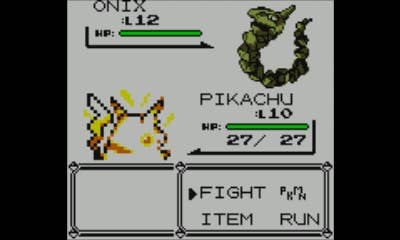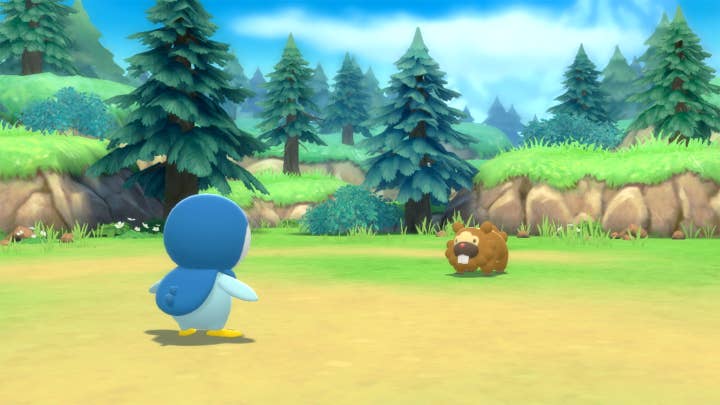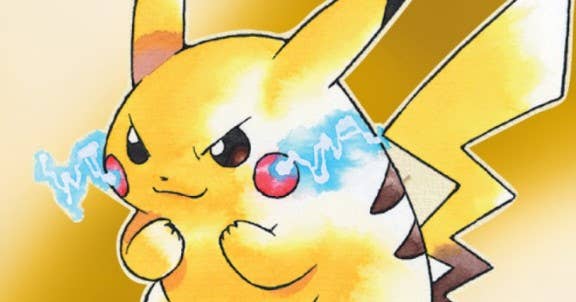The biggest Pokémon game launches in UK history | UK Time Tunnel
We look at the launches of the last 21 mainline Pokémon games
Pokémon is 25 years old. Well, it is more than that if you live in Japan. For those in the US the franchise is a mere 24 years old, and for Europe, it's only just turned 23.
As a franchise, Pokémon is the eighth biggest in UK history (in terms of revenue). That covers 93 different SKUs, including different colour variations and all Pokémon spin-off titles. Pokémon core franchise titles account for 82% of entire Pokémon revenue so far.
If we just look a the Pokémon franchise over the last five years (2017-2021), it is the UK's fifth biggest series, and that's before factoring in Pokémon Legends: Arceus and Pokémon Scarlet and Violet.
The biggest UK Pokémon launches
With the successful launch of Pokémon Scarlet and Violet, our friends over at GfK have revealed the biggest Pokémon game launches -- i.e. first-week sales -- from the 'mainline' series of games. This data is only physical boxed sales and doesn't include digital downloads.
The 'mainline' series of games are Pokémon RPGs that follow the catching, battling, training mechanics that the series is famed for. So that includes all new 'generations' (From Red and Blue, to Scarlet and Violet), enhanced versions (such as Yellow, Crystal, Emerald, Ultra Sun and Ultra Moon), and remakes (including Let's Go Pikachu and Eevee). Where there are two versions of the same game (as in most cases), we have combined the sales together.
The games that are not included are the spin-offs: Snap, Dash, Mystery Dungeon, Pokken, Stadium, Ranger, Art Academy, Pinball, Trading Card Game and so on.
Pokémon Red and Blue launched in the UK in October 1999, and its debut was relatively muted. In Japan, it launched for the original Game Boy in February 1996, and in the US in September 1998. By the time it landed in the UK, the original Game Boy had made way for the improved Game Boy Color, but neither Red or Blue made use of the new hardware.
It remains the smallest selling Pokémon game launch so far (unless you count the retro re-release of Gold and Silver on 3DS).
Yet Red and Blue, along with a popular trading card game and a hit anime series, fired Pokémon into the UK mainstream. It became a phenomenon. In June 2000, Pokémon Yellow launched. This was an enhanced version of Red and Blue, featuring elements of the cartoon and even included some splashes of colour that were absent from the 1998 Japanese release (as that was before the Game Boy Color was released). The game was a hit, and remains the eighth biggest Pokémon game launch in the franchise's history.

The first full sequels, Pokémon Gold and Silver, arrived in April 2021 in the UK. The games made full use of the Game Boy Color this time (although was still playable on the original Game Boy), and was widely acclaimed. However, launch sales were marginally weaker than Yellow, as Pokémon mania continued to wane. Indeed, Pokémon Crystal -- an enhanced version of Gold and Silver that only worked on Game Boy Color -- was one of the weakest Pokémon game launches when it arrived later that year.
Although Pokémon remained a big name, launch sales continued to slow as the series moved onto the Game Boy Advance. Pokémon Ruby and Sapphire arrived in July 2003, and again launch sales dropped over the previous Gold and Silver. The Game Boy Advance was popular in the UK, but didn't have the install base of the original Game Boy line, which was on sale throughout the 1990s.
Ruby and Sapphire remained the high point for Pokémon on GBA. In October 2004, the first Pokémon remakes appeared -- Fire Red and Leaf Green. At launch, the games sold more than double what the originals managed back in 1999, but sold half the number of copies of Pokémon Yellow.
The following year, in November 2005, Pokémon Emerald -- an enhanced version of Ruby and Sapphire -- arrived on shelves. This game sold almost exactly the same number of copies as the previous 'enhanced' game -- Pokémon Crystal -- and was the weakest of all Pokémon launches on the platform.
Come the launch of Nintendo DS, and after years of decline, Pokémon started to grow again. Pokémon Diamond and Pearl released in July 2007, and its launch sales were above anything achieved on GBA, and only marginally below Pokémon Gold and Silver.
Nintendo DS was one of the biggest games consoles on the planet at that point, and Pokémon was one of the platform's most successful games. In May 2009, we had the release of Pokémon Platinum, an enhanced version of Diamond and Pearl. This game would be the final time The Pokémon Company would release an enhanced 'third' version of its latest Pokémon games, and Platinum did substantially better than previous 'third versions' -- Pokémon Crystal and Emerald (but not Yellow).
Less than a year later, in March 2010, and Pokémon's growing popularity continued. The second set of remakes -- Pokémon Heartgold and SoulSilver -- was released on DS to huge numbers. The two titles outsold the original Gold and Silver games at launch, which continues a trend of the remakes out-performing the originals (a trend that is still the case today).
Pokémon's DS high point happened in March 2011 with the blockbuster launch of Black and White. Despite the ageing nature of the DS (the 3DS would launch later that same month), the first week sales of these games were huge, and at the time was the biggest Pokémon launch so far. It remains the sixth biggest today, and is beloved by fans.
As a result, Pokémon abandoned its 'third' game approach and developed a direct sequel to Black and White instead -- Black and White 2. The Pokémon Company made the decision to keep these games on the DS rather than develop for the new 3DS. The UK had long moved on from DS at this point, and Black and White 2 remains the smallest Pokémon games on DS, just behind Pokémon Platinum.

The increasing popularity of Pokémon continued onto the 3DS. Despite the 3DS being nowhere near as big as the DS, Pokémon X and Y in October 2013 had a big launch, and was only narrowly behind Black and White. The following year came another remake, Alpha Sapphire and Omega Ruby. These games launched in what is now seen as Pokémon's traditional release window of late November, and it was a big commercial hit. It narrowly outperformed Black and White and at the time was the franchise high point.
What followed was the return of Pokémon mania, which the game's 20th anniversary and the launch of Pokémon Go on smartphones. Pokémon games were constantly in the charts, and when Pokémon Sun and Moon launched in November 2016, the new releases flew off shelves. Sun and Moon are the biggset Pokémon game launches so far in terms of units, and it was the biggest in terms of revenue, although that crown has been taken by Scarlet and Violet. At launch, the game sold double what Alpha Sapphire and Omega Ruby managed.
Just like with Black and White 2, the next set of Pokémon games were released on a console that had been somewhat replaced. Ultra Sun and Ultra Moon were enhanced versions of the previous year's games, and they actually did rather well. They remain the second most successful 'enhanced' games in the series so far, behind Pokémon Yellow, and the Ultra games had a much bigger launch than Pokémon Black and White 2.
Now we are into the Switch era. The first Switch games, in November 2018, were Pokémon Let's Go Eevee and Let's Go Pikachu. These games were designed to appeal to the new audience that had come in via Pokémon Go, with more accessible gameplay. They are technically remakes of Pokémon Red and Blue, and the launch was strong. It sold better than previous games set in the same world (including Red/Blue, Yellow and Leaf Green/Fire Red), but the games were not as popular with hardcore players.
A year later, again in November, came the first new mainline Pokémon games on Switch -- Sword and Shield. The Switch was the hottest console of the market at this point, and it wasn't a surprise to see the games become the second biggest Pokémon game launches so far (at the time), and one of the Switch's fastest-selling games. At this point, digital downloading was accelerating, but we do not have access to those figures.
After that, Pokémon took a rare year off -- sort-of. Instead of 'enhanced' versions or sequels, The Pokémon Company decided to support Sword and Shield with DLC instead, extending the life of those games through added content, rather than the same game enhanced.
2021 saw the next set of Pokémon remakes -- Brilliant Diamond and Shining Pearl. The game is currently the seventh biggest Pokémon launch in UK charts history (but it was fifth when it launched), but is only narrowly behind Black and White and Alpha Sapphire and Omega Ruby. Sales of the remakes are 53% higher than the original Diamond and Pearl. With digital, that will have been even higher, and it's reasonable to assume the game would have appeared higher on the list.
Now we reach 2022. The biggest year for Pokémon so far, with two major Pokémon titles. In January we saw the release of Pokémon Legends: Arceus. This new take on the series was a surprise hit, and actually out-performed the Diamond and Pearl remakes from the year before. It is currently the fourth biggest launch in Pokémon history, despite launching in a traditional quiet month.
That turned out to be the warm up. In November, the next new generation of Pokémon titles were released: Pokémon Scarlet and Violet. These are the second biggest Pokémon titles ever (behind Sun and Moon), but in terms of revenue, they're actually the biggest Pokémon games of all time (the game was £13 more expensive at launch.
Scarlet and Violet was actually the biggest boxed game launch in the UK during 2022, and as a result, Pokémon was the UK's second biggest franchise of the year, behind FIFA.
Biggest UK Pokémon Mainline Game Launches - Units (GfK Entertainment data)
| Position | Year | Title | Format |
|---|---|---|---|
| 1 | 2016 | Pokémon Sun and Moon | Nintendo 3DS |
| 2 | 2022 | Pokémon Scarlet and Violet | Nintendo Switch |
| 3 | 2019 | Pokémon Sword and Shield | Nintendo Switch |
| 4 | 2022 | Pokémon Legends: Arceus | Nintendo Switch |
| 5 | 2014 | Pokémon Alpha Sapphire and Omega Ruby | Nintendo 3DS |
| 6 | 2011 | Pokémon Black and White | Nintendo DS |
| 7 | 2021 | Pokémon Brilliant Diamond and Shining Pearl | Nintendo Switch |
| 8 | 2013 | Pokémon X and Y | Nintendo 3DS |
| 9 | 2018 | Pokémon Let's Go Eevee and Let's Go Pikachu | Nintendo Switch |
| 10 | 2000 | Pokémon Yellow | Gameboy/Gameboy Color |
| 11 | 2010 | Pokémon Heart Gold and Soul Silver | Nintendo DS |
| 12 | 2001 | Pokémon Gold and Silver | Gameboy/Gameboy Color |
| 13 | 2007 | Pokémon Diamond and Pearl | Nintendo DS |
| 14 | 2003 | Pokémon Ruby and Sapphire | Gameboy Advance |
| 15 | 2017 | Pokémon Ultra Sun and Ultra Moon | Nintendo 3DS |
| 16 | 2009 | Pokémon Platinum | Nintendo DS |
| 17 | 2012 | Pokémon Black and White 2 | Nintendo DS |
| 18 | 2004 | Pokémon Leaf Green and Fire Red | Gameboy Advance |
| 19 | 2005 | Pokémon Emerald | Gameboy Advance |
| 20 | 2001 | Pokémon Crystal | Gameboy Color |
| 21 | 1999 | Pokémon Red and Blue | Gameboy |
Biggest UK Pokémon Mainline Game Launches - Revenue (GfK Entertainment data)
| Position | Year | Title | Format |
|---|---|---|---|
| 2 | 2022 | Pokémon Scarlet and Violet | Nintendo Switch |
| 2 | 2016 | Pokémon Sun and Moon | Nintendo 3DS |
| 3 | 2019 | Pokémon Sword and Shield | Nintendo Switch |
| 4 | 2021 | Pokémon Brilliant Diamond and Shining Pearl | Nintendo Switch |
| 5 | 2022 | Pokémon Legends: Arceus | Nintendo Switch |
| 6 | 2014 | Pokémon Alpha Sapphire and Omega Ruby | Nintendo 3DS |
| 7 | 2018 | Pokémon Let's Go Eevee and Let's Go Pikachu | Nintendo Switch |
| 8 | 2013 | Pokémon X and Y | Nintendo 3DS |
| 9 | 2011 | Pokémon Black and White | Nintendo DS |
| 10 | 2017 | Pokémon Ultra Moon and Ultra Sun | 3DS |

